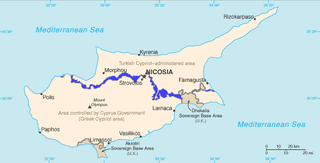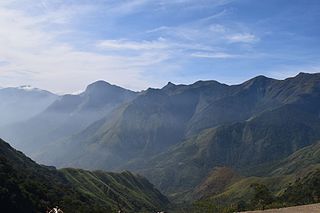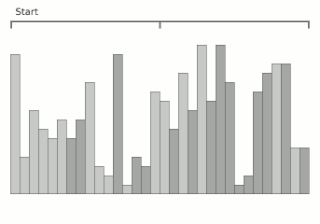A buffer solution is a solution where the pH does not change significantly on dilution or if an acid or base is added at constant temperature. Its pH changes very little when a small amount of strong acid or base is added to it. Buffer solutions are used as a means of keeping pH at a nearly constant value in a wide variety of chemical applications. In nature, there are many living systems that use buffering for pH regulation. For example, the bicarbonate buffering system is used to regulate the pH of blood, and bicarbonate also acts as a buffer in the ocean.

Polyacrylamide gel electrophoresis (PAGE) is a technique widely used in biochemistry, forensic chemistry, genetics, molecular biology and biotechnology to separate biological macromolecules, usually proteins or nucleic acids, according to their electrophoretic mobility. Electrophoretic mobility is a function of the length, conformation, and charge of the molecule. Polyacrylamide gel electrophoresis is a powerful tool used to analyze RNA samples. When polyacrylamide gel is denatured after electrophoresis, it provides information on the sample composition of the RNA species.

A depth buffer, also known as a z-buffer, is a type of data buffer used in computer graphics to represent depth information of objects in 3D space from a particular perspective. The depth is stored as a height map of the scene, the values representing a distance to camera, with 0 being the closest. The encoding scheme may be flipped with the highest number being the value closest to camera. Depth buffers are an aid to rendering a scene to ensure that the correct polygons properly occlude other polygons. Z-buffering was first described in 1974 by Wolfgang Straßer in his PhD thesis on fast algorithms for rendering occluded objects. A similar solution to determining overlapping polygons is the painter's algorithm, which is capable of handling non-opaque scene elements, though at the cost of efficiency and incorrect results.

A framebuffer is a portion of random-access memory (RAM) containing a bitmap that drives a video display. It is a memory buffer containing data representing all the pixels in a complete video frame. Modern video cards contain framebuffer circuitry in their cores. This circuitry converts an in-memory bitmap into a video signal that can be displayed on a computer monitor.

A buffer zone, also historically known as a march, is a neutral area that lies between two or more bodies of land; usually, between countries. Depending on the type of buffer zone, it may serve to separate regions or conjoin them. Common types of buffer zones are demilitarized zones, border zones and certain restrictive easement zones and green belts. Such zones may be comprised by a sovereign state, forming a buffer state.

A coupling or coupler is a mechanism, typically located at each end of a rail vehicle, that connects them together to form a train. The equipment that connects the couplers to the vehicles is the draft gear or draw gear, which must absorb the stresses of the coupling and the acceleration of the train.

Silent Valley National Park is a national park in Kerala, India. It is located in the Nilgiri hills and has a core area of 89.52 km2 (34.56 sq mi). It is surrounded by a buffer zone of 148 km2 (57 sq mi). This national park has some rare species of flora and fauna. Silent Valley National Park was explored in 1847 by the botanist Robert Wight. It is located in the border of Mannarkkad Taluk of Palakkad district, Nilambur Taluk of Malappuram district, Kerala, and Nilgiris district of Tamil Nadu.
In mathematics, the sieve of Atkin is a modern algorithm for finding all prime numbers up to a specified integer. Compared with the ancient sieve of Eratosthenes, which marks off multiples of primes, the sieve of Atkin does some preliminary work and then marks off multiples of squares of primes, thus achieving a better theoretical asymptotic complexity. It was created in 2003 by A. O. L. Atkin and Daniel J. Bernstein.

Quicksort is an efficient, general-purpose sorting algorithm. Quicksort was developed by British computer scientist Tony Hoare in 1959 and published in 1961. It is still a commonly used algorithm for sorting. Overall, it is slightly faster than merge sort and heapsort for randomized data, particularly on larger distributions.

The bobak marmot, also known as the steppe marmot, is a species of marmot that inhabits the steppes of Eastern Europe and Central Asia. It is a social animal and inhabits steppe grassland, including cultivated field borders. It hibernates for more than half the year. Litter sizes average about five offspring and it takes three years for the young marmots to reach sexual maturity. Male offspring leave the home colony after their second winter, and about 60% of mature females give birth in any one year.

PIPES is a frequently used buffering agent in biochemistry. It is an ethanesulfonic acid buffer developed by Good et al. in the 1960s.
Acid–base homeostasis is the homeostatic regulation of the pH of the body's extracellular fluid (ECF). The proper balance between the acids and bases in the ECF is crucial for the normal physiology of the body—and for cellular metabolism. The pH of the intracellular fluid and the extracellular fluid need to be maintained at a constant level.
In computing, the producer-consumer problem is a family of problems described by Edsger W. Dijkstra since 1965.

CHES is a buffering agent. CHES buffers have a useful range of pH 8.6–10.

In computer science, a circular buffer, circular queue, cyclic buffer or ring buffer is a data structure that uses a single, fixed-size buffer as if it were connected end-to-end. This structure lends itself easily to buffering data streams. There were early circular buffer implementations in hardware.

In computer science, the log-structured merge-tree is a data structure with performance characteristics that make it attractive for providing indexed access to files with high insert volume, such as transactional log data. LSM trees, like other search trees, maintain key-value pairs. LSM trees maintain data in two or more separate structures, each of which is optimized for its respective underlying storage medium; data is synchronized between the two structures efficiently, in batches.
In computer science, a fractal tree index is a tree data structure that keeps data sorted and allows searches and sequential access in the same time as a B-tree but with insertions and deletions that are asymptotically faster than a B-tree. Like a B-tree, a fractal tree index is a generalization of a binary search tree in that a node can have more than two children. Furthermore, unlike a B-tree, a fractal tree index has buffers at each node, which allow insertions, deletions and other changes to be stored in intermediate locations. The goal of the buffers is to schedule disk writes so that each write performs a large amount of useful work, thereby avoiding the worst-case performance of B-trees, in which each disk write may change a small amount of data on disk. Like a B-tree, fractal tree indexes are optimized for systems that read and write large blocks of data. The fractal tree index has been commercialized in databases by Tokutek. Originally, it was implemented as a cache-oblivious lookahead array, but the current implementation is an extension of the Bε tree. The Bε is related to the Buffered Repository Tree. The Buffered Repository Tree has degree 2, whereas the Bε tree has degree Bε. The fractal tree index has also been used in a prototype filesystem. An open source implementation of the fractal tree index is available, which demonstrates the implementation details outlined below.

Block sort, or block merge sort, is a sorting algorithm combining at least two merge operations with an insertion sort to arrive at O(n log n) (see Big O notation) in-place stable sorting time. It gets its name from the observation that merging two sorted lists, A and B, is equivalent to breaking A into evenly sized blocks, inserting each A block into B under special rules, and merging AB pairs.

Karimpuzha Wildlife Sanctuary is located on the western slopes of Nilgiris, lies between the geographical limits of N 11o23’15’’to 11o12’43’’ latitudes and E 76o22’37’’ to 76o33’2’’ longitudes and falls in the Nilambur Taluk of Malappuram Revenue District in Kerala. Karimpuzha WLS area forms part of the revenue villages of Karulai, Moothedam and Amarambalam. The sharp topographical gradient of the hills ranging from 40 m to 2550 m is the primary reason for the unique biodiversity of the Karimpuzha WLS.

Nahá–Metzabok Biosphere Reserve is a biosphere reserve in southeastern Mexico. It is located in the state of Chiapas, on the northeastern flank of the Chiapas Highlands. The reserve protects montane rain forests, pine and oak forests, and natural lakes.

















